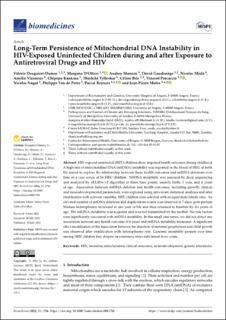| dc.contributor.author | Desquiret-Dumas, Valérie | |
| dc.contributor.author | D’Ottavi, Morgana | |
| dc.contributor.author | Monnin, Audrey | |
| dc.contributor.author | Goudenège, David | |
| dc.contributor.author | Méda, Nicolas | |
| dc.contributor.author | Vizeneux, Amélie | |
| dc.contributor.author | Kankasa, Chipepo | |
| dc.contributor.author | Tylleskär, Thorkild | |
| dc.contributor.author | Bris, Céline | |
| dc.contributor.author | Procaccio, Vincent | |
| dc.contributor.author | Nagot, Nicolas | |
| dc.contributor.author | Van de Perre, Philippe | |
| dc.contributor.author | Reynier, Pascal | |
| dc.contributor.author | Molès, Jean-Pierre | |
| dc.date.accessioned | 2022-12-29T13:20:38Z | |
| dc.date.available | 2022-12-29T13:20:38Z | |
| dc.date.created | 2022-09-16T13:09:21Z | |
| dc.date.issued | 2022 | |
| dc.identifier.issn | 2227-9059 | |
| dc.identifier.uri | https://hdl.handle.net/11250/3039902 | |
| dc.description.abstract | HIV-exposed uninfected (HEU) children show impaired health outcomes during childhood. A high rate of mitochondrial DNA (mtDNA) instability was reported in the blood of HEU at birth. We aimed to explore the relationship between these health outcomes and mtDNA deletions over time in a case series of 24 HEU children. MtDNA instability was assessed by deep sequencing and analyzed by eKLIPse-v2 algorithm at three time points, namely birth, 1 year, and 6 years of age. Association between mtDNA deletion and health outcomes, including growth, clinical, and neurodevelopmental parameters, were explored using univariate statistical analyses and after stratification with relevant variables. HEU children were selected with an equal male:female ratio. An elevated number of mtDNA deletions and duplications events was observed at 7 days’ post-partum. Median heteroplasmy increased at one year of life and then returned to baseline by six years of age. The mtDNA instability was acquired and was not transmitted by the mother. No risk factors were significantly associated with mtDNA instability. In this small case series, we did not detect any association between any health outcome at 6 years and mtDNA instability measures. A significant effect modification of the association between the duration of maternal prophylaxis and child growth was observed after stratification with heteroplasmy rate. Genomic instability persists over time among HEU children but, despite its extension, stays subclinical at six years. | en_US |
| dc.language.iso | eng | en_US |
| dc.publisher | MDPI | en_US |
| dc.rights | Navngivelse 4.0 Internasjonal | * |
| dc.rights.uri | http://creativecommons.org/licenses/by/4.0/deed.no | * |
| dc.title | Long-term persistence of mitochondrial DNA instability in HIV-exposed uninfected children during and after exposure to antiretroviral drugs and HIV | en_US |
| dc.type | Journal article | en_US |
| dc.type | Peer reviewed | en_US |
| dc.description.version | publishedVersion | en_US |
| dc.rights.holder | Copyright 2022 The Author(s) | en_US |
| dc.source.articlenumber | 1786 | en_US |
| cristin.ispublished | true | |
| cristin.fulltext | original | |
| cristin.qualitycode | 1 | |
| dc.identifier.doi | 10.3390/biomedicines10081786 | |
| dc.identifier.cristin | 2052485 | |
| dc.source.journal | Biomedicines | en_US |
| dc.identifier.citation | Biomedicines. 2022, 10 (8), 1786. | en_US |
| dc.source.volume | 10 | en_US |
| dc.source.issue | 8 | en_US |

